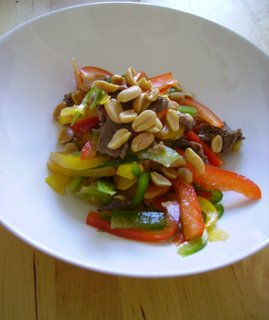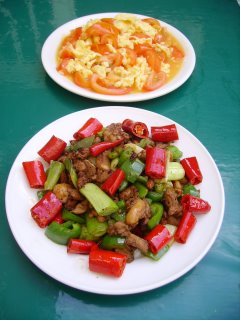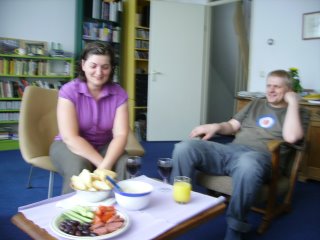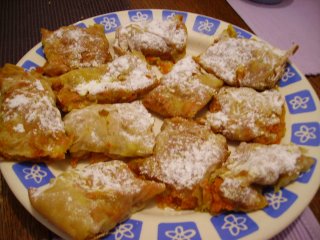
When I see all the ingredients Bibi has gathered around her to prepare the Thai meal, I am seriously intimidated. I give up ever recreating this meal before she has even started. When she tells me she's planning to open a Thai restaurant, I feel somewhat better...I'm dealing with a professional here.
Like Mike (from my Chinese meal), Bibi is a "European" name, as her Thai name is too long and complicated to pronounce for most Westerners.
Most Thai have a nickname, and even the
 kings are not known by their full name! Bibi says:"We just call them King nr. 5 or King nr. 9."
kings are not known by their full name! Bibi says:"We just call them King nr. 5 or King nr. 9."
 Our meal starts with little snacks; egg rolls, meat patties and frothy omelet. The omelet is so airy because it's poured into the pan from great heights...Bibi jokes:"We will pour it from the second floor, if we want it to be really light!"
Our meal starts with little snacks; egg rolls, meat patties and frothy omelet. The omelet is so airy because it's poured into the pan from great heights...Bibi jokes:"We will pour it from the second floor, if we want it to be really light!"
Like Mike (from my Chinese meal), Bibi is a "European" name, as her Thai name is too long and complicated to pronounce for most Westerners.
Most Thai have a nickname, and even the
 kings are not known by their full name! Bibi says:"We just call them King nr. 5 or King nr. 9."
kings are not known by their full name! Bibi says:"We just call them King nr. 5 or King nr. 9."The official name for Bangkok is so long, there's even a special song to help you remember is. Mostly it's just called Krung Thep, which roughly translates into "City of Angels". Anyway, Bibi isn't even from Bangkok!
While I'm helping her remove the heads of the big shrimp for our soup, she explains how she  needs to be in a good mood while cooking: "I have to be in a good mood for the food to taste good! If I'm in a bad mood, the dishes somehow always turn out too salty or too sweet..."
needs to be in a good mood while cooking: "I have to be in a good mood for the food to taste good! If I'm in a bad mood, the dishes somehow always turn out too salty or too sweet..."
 needs to be in a good mood while cooking: "I have to be in a good mood for the food to taste good! If I'm in a bad mood, the dishes somehow always turn out too salty or too sweet..."
needs to be in a good mood while cooking: "I have to be in a good mood for the food to taste good! If I'm in a bad mood, the dishes somehow always turn out too salty or too sweet..."I'd never heard that before!
As she is cooking for non-Thai, Bibi has been so nice as to adapt the level of hotness to our tastes. She says what we are eating is "children's level". She herself always brings a little box of chili powder whenever she's eating out or at a restaurant. This way, she can surreptitiously add a bit of spice to the dishes that taste very bland to her.
But even within Thai adults there is a variation in what people can stand. Bibi's aunt cooks such spicy food that Bibi's father will not accept dinner invitations to her home anymore!
 Our meal starts with little snacks; egg rolls, meat patties and frothy omelet. The omelet is so airy because it's poured into the pan from great heights...Bibi jokes:"We will pour it from the second floor, if we want it to be really light!"
Our meal starts with little snacks; egg rolls, meat patties and frothy omelet. The omelet is so airy because it's poured into the pan from great heights...Bibi jokes:"We will pour it from the second floor, if we want it to be really light!"The spicy Thom Yum Kung, brings a nice flush to my cheeks and every spoonful springs a new surprise of mushrooms, coriander or shrimp. Somehow I find it impossible to make good pictures of the food this time. Especially of the main dish, white rice with Beef Curry Matsaman. This is a special recipe, originally only eaten in the King's Palace, according to Bibi. "Every dish has a story in Thailand."
spoonful springs a new surprise of mushrooms, coriander or shrimp. Somehow I find it impossible to make good pictures of the food this time. Especially of the main dish, white rice with Beef Curry Matsaman. This is a special recipe, originally only eaten in the King's Palace, according to Bibi. "Every dish has a story in Thailand."
 spoonful springs a new surprise of mushrooms, coriander or shrimp. Somehow I find it impossible to make good pictures of the food this time. Especially of the main dish, white rice with Beef Curry Matsaman. This is a special recipe, originally only eaten in the King's Palace, according to Bibi. "Every dish has a story in Thailand."
spoonful springs a new surprise of mushrooms, coriander or shrimp. Somehow I find it impossible to make good pictures of the food this time. Especially of the main dish, white rice with Beef Curry Matsaman. This is a special recipe, originally only eaten in the King's Palace, according to Bibi. "Every dish has a story in Thailand."I feel blessed to be able to taste it on this cold rainy winter day in Holland.
As a final lesson, Bibi shows me how to make a spring roll with a napkin (photo at right). I still feel as if I'm in a course about Shakespeare before even learning the alphabet! If she does indeed open a restaurant, I will be the first visitor.










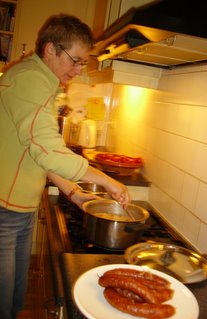

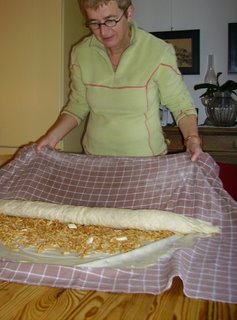

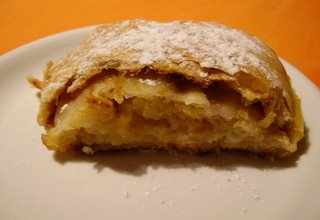
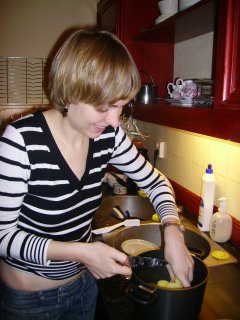
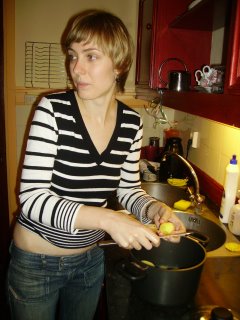

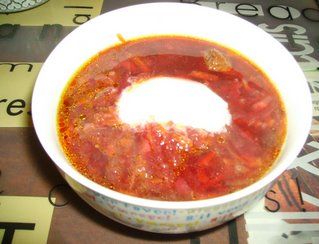

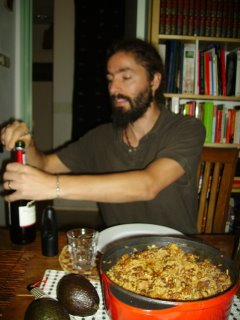

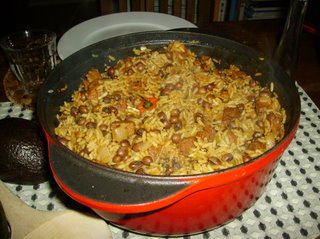
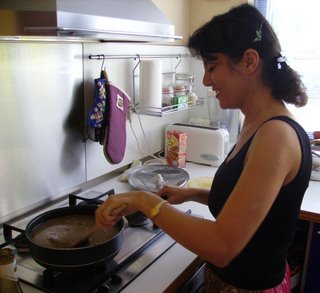







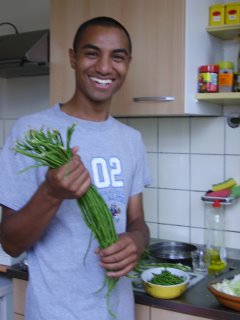 Tonight a Surinamese meal with reknowned cook Martin and his girlfriend Liza, in their sunny garden terrace. Martin tells me he could have made many different dishes: Surinam has as many cuisines as it has ethnic groups. His own roots seem to cover the whole spectrum...he's part Chinese, Indian, Creole and Javanese. His great-aunt ("Oma Tjoekop") provided the "Indonesian" part of this meal: the peanut sauce. Though she still lives in Surinam, she is Martin's source of the dried concentrate he needs to make the spicy sauce. "I wouldn't dare prepare this dish without it!" he confesses.
Tonight a Surinamese meal with reknowned cook Martin and his girlfriend Liza, in their sunny garden terrace. Martin tells me he could have made many different dishes: Surinam has as many cuisines as it has ethnic groups. His own roots seem to cover the whole spectrum...he's part Chinese, Indian, Creole and Javanese. His great-aunt ("Oma Tjoekop") provided the "Indonesian" part of this meal: the peanut sauce. Though she still lives in Surinam, she is Martin's source of the dried concentrate he needs to make the spicy sauce. "I wouldn't dare prepare this dish without it!" he confesses.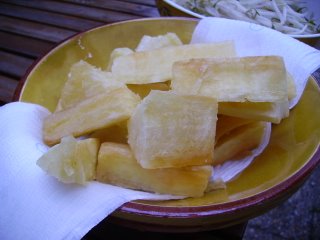

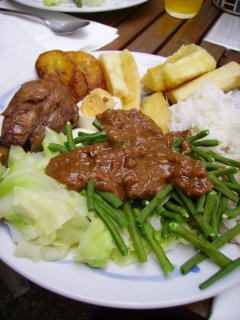
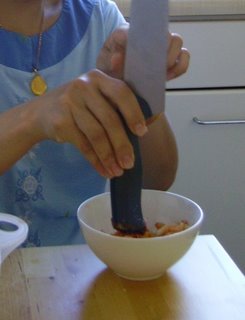 An has lived in the Netherlands for three years now, and has already developed a taste for zuurkool, otherwise known as sauerkraut. She likes to add sugar, thus creating a nice sweet and sour taste. An:"My parents are from the North of Vietnam, and that is where I grew up. In the North, we prefer our food to be quite simple. The predominant taste is salty. I have lived in the South too, where they like sweet dishes. And my husband is from the centre, where the food is spicy!"
An has lived in the Netherlands for three years now, and has already developed a taste for zuurkool, otherwise known as sauerkraut. She likes to add sugar, thus creating a nice sweet and sour taste. An:"My parents are from the North of Vietnam, and that is where I grew up. In the North, we prefer our food to be quite simple. The predominant taste is salty. I have lived in the South too, where they like sweet dishes. And my husband is from the centre, where the food is spicy!"